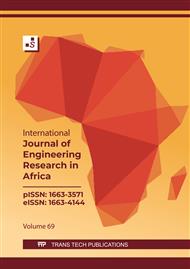[1]
R. S. Velazquez-Gonzalez, A. L. Garcia-Garcia, E. Ventura-Zapata, J. D. O. Barceinas-Sanchez, J. C. Sosa-Savedra, A review on hydroponics and the technologies associated for medium-and small-scale operations, Agriculture. 12 (2022) 646.
DOI: 10.3390/agriculture12050646
Google Scholar
[2]
S.H. Muhie, Novel approaches and practices to sustainable agriculture, Journal of Agriculture and Food Research. 10 (2022) 100446.
DOI: 10.1016/j.jafr.2022.100446
Google Scholar
[3]
B. Von Elsner, D. Briassoulis, D. Waaijenberg, A. Mistriotis, C. Von Zabeltitz, J. Gratraud, R. Suay-Cortes, Review of structural and functional characteristics of greenhouses in European Union countries: Part I, design requirements, Journal of Agricultural Engineering Research. 75 (2000) 1-16.
DOI: 10.1006/jaer.1999.0502
Google Scholar
[4]
B. Von Elsner, D. Briassoulis, D. Waaijenberg, A. Mistriotis, C. Von Zabeltitz, J. Gratraud, R. Suay-Cortes. Review of structural and functional characteristics of greenhouses in European Union countries, part II: Typical designs, Journal of agricultural engineering research. 75 (2000) 111-126.
DOI: 10.1006/jaer.1999.0512
Google Scholar
[5]
P. Martínez-Gómez, S. Rahimi Devin, J.A. Salazar, J. López-Alcolea, M. Rubio, P,J, Martínez-Garcí, Principles and prospects of prunus cultivation in greenhouse, Agronomy. 11 (2021) 474.
DOI: 10.3390/agronomy11030474
Google Scholar
[6]
R. S. Riseh, E. Tamanadar, M. M. Pour, V. K. Thakur, Novel approaches for encapsulation of plant probiotic bacteria with sustainable polymer gums: application in the management of pests and diseases, Advances in Polymer Technology. 2022 (2022) 1-10.
DOI: 10.1155/2022/4419409
Google Scholar
[7]
G. E. Barrett, P. D. Alexander, J. S. Robinson, N. C. Bragg, Achieving environmentally sustainable growing media for soilless plant cultivation systems–A review, Scientia horticulturae. 212 (2016) 220-234.
DOI: 10.1016/j.scienta.2016.09.030
Google Scholar
[8]
D. M. Atia, H. T. El-madany, Analysis and design of greenhouse temperature control using adaptive neuro-fuzzy inference system, Journal of Electrical Systems and Information Technology. 4 (2017) 34-48.
DOI: 10.1016/j.jesit.2016.10.014
Google Scholar
[9]
R.V. Chimankare, S. Das, K.. Kaur, D. Magare, A review study on the design and control of optimised greenhouse environments, Journal of Tropical Ecology. 39 (2023) e26.
DOI: 10.1017/s0266467423000160
Google Scholar
[10]
J.A. Pucheta, C. Schugurensky, R. Fullana, H. Patiño, B. Kuchen, Optimal greenhouse control of tomato-seedling crops, Computers and electronics in agriculture. 50 (2006) 70-82.
DOI: 10.1016/j.compag.2005.09.002
Google Scholar
[11]
E.H. Gurban, G. D. Andreescu, Comparison study of PID controller tuning for greenhouse climate with feedback-feedforward linearization and decoupling, In 2012 16th international conference on system theory, control and computing (icstcc). (2012) 1-6.
Google Scholar
[12]
W.H. Chen, F. You, Efficient Greenhouse temperature control with data-driven robust model predictive, In 2020 American Control Conference (ACC). (2020) 1986-1991.
DOI: 10.23919/acc45564.2020.9147701
Google Scholar
[13]
G. D. Pasgianos, K. G. Arvanitis, P. Polycarpou, N. Sigrimis, A nonlinear feedback technique for greenhouse environmental control, Computers and electronics in agriculture. 40 (2003) 153-177.
DOI: 10.1016/s0168-1699(03)00018-8
Google Scholar
[14]
G.D. Pasgianos, K.G. Arvanitis, N.A. Sigrimis, A Non-Linear Feedback Technique for Greenhouse Environmental Control, IFAC Proceedings. 34 (2001) 105-112.
DOI: 10.1016/s1474-6670(17)33641-8
Google Scholar
[15]
P.I. Daskalov, K. G. Arvanitis, G. D. Pasgianos, N. A. Sigrimis, Non-linear adaptive temperature and humidity control in animal buildings, Biosystems Engineering. 93 (2006) 1-24.
DOI: 10.1016/j.biosystemseng.2005.09.006
Google Scholar
[16]
Y. Gao, X. Song, C. Liu, S. He, Feedback feed-forward linearization and decoupling for greenhouse environment control, In 2014 International Conference on Mechatronics and Control (ICMC). (2014) 179-183.
DOI: 10.1109/icmc.2014.7231543
Google Scholar
[17]
X. Luan, P. Shi, F. Liu, Robust adaptive control for greenhouse climate using neural networks, International Journal of Robust and Nonlinear Control. 21 (2011) 815-826.
DOI: 10.1002/rnc.1630
Google Scholar
[18]
M. Furat, I. Eker, Chattering-eliminated adaptive sliding-mode control: an experimental comparison study, Turkish Journal of Electrical Engineering and Computer Sciences. 24 (2016) 605-620.
DOI: 10.3906/elk-1309-137
Google Scholar
[19]
J.Y. Hung, W. Gao, J.C. Hung, Variable structure control: A survey, IEEE transactions on industrial electronics. 40 (1993) 2-22.
DOI: 10.1109/41.184817
Google Scholar
[20]
W.D. Chang, J.J. Yan, Adaptive robust PID controller design based on a sliding mode for uncertain chaotic systems, Chaos, Solitons & Fractals. 26 (2005) 167-175.
DOI: 10.1016/j.chaos.2004.12.013
Google Scholar
[21]
J. J. Slotine, W. Li, Applied nonlinear control, NJ: Prentice hall, New Jersey, 1991.
Google Scholar
[22]
J. Liu, X. Wang. Advanced sliding mode control for mechanical systems: Design, analysis and MATLAB simulation. Springer, Berlin, 2012.
Google Scholar
[23]
G. L. Guo, C. M. Lin, H. Y. Cho, D. H. Pham, T. T. Huynh, F. Chao, Decoupled sliding mode control of underactuated nonlinear systems using a fuzzy brain emotional cerebellar model control system, International Journal of Fuzzy Systems. 25 (2023) 15-28.
DOI: 10.1007/s40815-022-01378-w
Google Scholar
[24]
J.J. Moghaddam, G. Zarei, D. Momeni, H. Faridi, Non-linear control model for use in greenhouse climate control systems, Research in Agricultural Engineering. 68 (2022) 9-17.
DOI: 10.17221/37/2021-rae
Google Scholar


